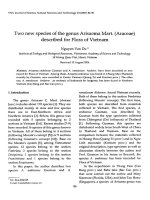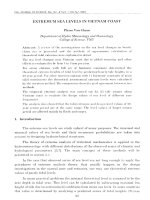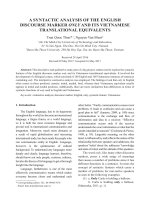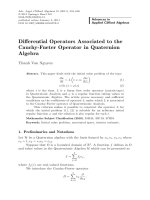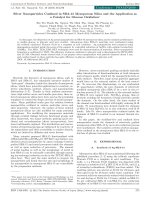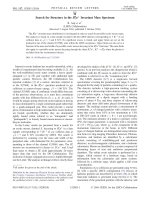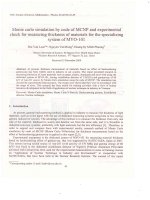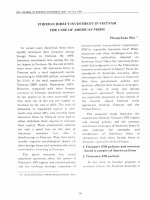DSpace at VNU: Cerenkov radiation simulation in the auger water ground detec tor
Bạn đang xem bản rút gọn của tài liệu. Xem và tải ngay bản đầy đủ của tài liệu tại đây (2.75 MB, 9 trang )
VNU JOURNAL OF SCIENCE. Mathematics - Physics, t.XVIII. n°l - 2002
C E R E N K O V R A D IA TIO N SIM ULA TIO N IN
T H E A U G ER W ATER G R O U N D D E T E C T O R
L e V a n N g o c , V o V a n T h u a n a n d D a n g Q u a iig T h ie u
Institute o f N uclear Science and Technique
A b s t r a c t . The sim ulation of response o f the A uger water C crcnkov ground dctcctof
ft) atmospheric shower muons is practically needed f o r the experimental research
of cosmic rays at extreme energies. We consider herd a sim ulation model f o r thr
p ro a ss of ('.mission and diffusion of Cerenkov photons concerned with muons moving
tliwugh the detector volume with the velocity greater than the phase velocity o f light
in the water on purpose to define photons producing signal ill the detector.
I. I n t r o d u c t io n
In 1962 one observed cosm ic rays w ith energy approxim ate to 10~° eV . In 30 subse
quent. yciiirs 8 extensive atm ospheric showers vvil.il energy exceeding 1()~° eV wen! observed.
How is it possible to explain the existen ce of these extraordinarily energetic cosmic rays.
T his is a scientific m istery which there have not been reliable .schemes for explaining. If
understood th e source and nature o f extrem ely high-energy cosm ic rays are. we will lead
to new discoveries or ill th e fundam ental physics or in the astrophysics.
In recent years the interest ill cosm ic rays at extrem e energies has increased rapidly.
The experim ental study o f such cosm ic rays will be carried out w ithin the framework
o f the international Pierre Auger project w ith Auger observatories o f a hybrid design
including fluorescence detectors used to observe th e longitudinal developm ent of showers
ill the atm osphere and water Cerenkov ground detector arrays to sam ple th e lateral density
distribut ion OI1 the ground level 11, 21
T h e sim ulation of response of the water Cerenkov ground detector to atm ospheric
shower muons is pract ically needed for th e experim ental research o f extrem ely high energy
cosm ic rays. In th is paper we develop a sim ulation m odel for the process o f emission and
diffusion of Cererikov photons concerned with m uons passing through th e detector volume
with the velocity greater than the phase velocity of light in the water on purpose to define
photons producing signal in th e detector.
II. S im u la tio n m o d e l fo r g e n e r a t io n a n d r a y -tr a c e o f C e r e n k o v p h o t o n s in th e
a u g e r w a te r g r o u n d d e t e c t o r
T he Auger water Cerenkov ground detector considered in our m odel is a 10 1112 <
1.2m deep cylindrical volum e of water, lined w ith a diffusely reflective w h ite material, and
viewed vertically from above by 3 photom ultiplier tubes (pints)
200m m in diam eter.
T he detector geom etry is illustrated oil the figure 1.
T y p e s e t by .4 v fS -T £ X
28
Cerankov radiation sim u la tio n in the.
For sinm lntion. I hr p i n t s arc approxim ated as circular areas in the plane of the
detector top surface witli area equal to the effective area of 200nim pints (5 3 0 n n 2).
v z
F k j m v 1. Illustration of the Auger water ground detector geometry.
W hen an atm ospheric shower muon strikes the top surface of the detector and
move's through its volume w ith the velocity greater than the phase velocity of light, in the
water the Corenkov photons are em itted. T hese Cerenkov photons are the optical photons.
Passing through ihv water th ey undergo throe kinds of interaction: R ayleigh scattering,
absorption and water boundary interaction (absorption and reflection). However. ễt\n tho
water contained ill tilt* detector volum e is purified, it may be considered as an optically
hom ogenous medium and therefore tile Rayleigh scat tering is negligible.
T he motion of 1he* atm ospheric shower muon through th e detector volum e ac
com panied by the pn xrsses: the energy loss for ionization and atom ic excitation, the
hrcm sstrahlung. the direct pair v ¥e production. T he M onte-Carlo algorithm s for sim u
lât ion of th e hrcmsst-rahluug and direct pair fã' ( production processes have Ixvn analyzed
in detail by IIS in [3|. However, at energies sm aller than 2 TeV (th e energies which most
o f atm ospheric shower muons have on the ground level) the ionization and excitation of
atom s are the main mechanism and both the hrem sstrahlung and direct pair r 4 e “ pro
duction processes may be neglected. T he sim ulation o f the generation and diffusion of
Ccrcnkov photons concerned w ith the muon m oving in the detector volum e can he carried
out then based 011 the sim ulation algorithm s developed by US as follows:
1. C alculating the characteristics of the considered muon: coordinates o f its position
(A'n,,.
the m oving direction
energy ( £ ,,) .
2. C alculating the threshold energy for Ceronkov radiation em ission according to the
coherent condition: //.? > 1
lires =
---------- -----
r1
(1)
where El) - the union energy at rest, n- the refractive index of the water, (3 = v /c .
3. Checking whet lier th e m uon’s energy E fi is
greater than th e thresold energy for
Cerenkov radiation em ission JE7|lires» or H°t- If E fl < z?thres* the calculation w ith the
considered nmon is ceased and t hen the operations are passed to performing with
Le
V an N goe,
Vo
Van T huan and D ang
Q u a n y T h ie u
a new muon (when a number o f given m uons. N ụ , rem ains in the m em ory o f the
com puter) by returning to 1. O therw ise, go to 4.
4. Advancing th e muon a rather sm all step . A /. along its m oving direction.
5. Verifying w hether
the final point o f A/ is inside the detector volum e or n o t by
calculating its coordinates:
X fl = X qh + A / sin 0fl COS ộự ,
Yịi = Yoịầ + A /sin ớ;4sin
(2)
= Xo/i + A / cos 0^.
If the final point of A / Is outside th e detector volum e, the calculation is finished
with the given muon. O therwise, go to 6.
6. C alculating Cerenkov radiation energy oil A /
dE
A Ev = =
dl
.
xAI,
(3)
here.
d E r _ 4 n - z 2e'2
di
c1
(
_____ 1
_ 2 /r W f
\
.. "V
"
J Ui
C2
_____ 1
[ l
\
n 20 2 )
2
2
“,ax
and
in -r I/max i‘s th e frequency band w ith in which the detector is sen sitive.
7. C alculating th e number o f Cerenkov ph otons em itted on A /. T h e average number
of Cerenkov photons produced on A / is defined by:
Ne = y x A i ,
(4)
here,
djV22^2 I'E, Mmx
/
d t = H W J r ....
1\ _ / 1\
) d E c ~ 37022 V1 “ ^
^ l 1" ^
) (£rm ax ■ E r,il", ) -
T hus the number of Cerenkov ph otons given ofl’ on A l is calculated according to
the Poisson distribution
P {n ) = e~K
X
Nn
- f
n!
(5)
by tile sim ulating form ula ft = fc , here Ả: is th e least w hole number taken so as to
satisfy th e inequality:
.= !
iVf
with the random numbers a , uniform ly distributed on ( 0,1).
Each Cerenkov photon generated OI1 A / is sim ulated then, in turn, as follows:
a. C alculating the em ission angle of photons produced on A /
cos“ = ả
<6)
C e r e n k o v r a d ia tio n s im u la tio n in th e ...
'M
I). C alculating th e azim uthal em ission angle of a photon em itted oil A /. It is chosen
at random from t lie uniform distribution on (0.2tt) according to th e formula Ộ = 27TO.O
- a random number uniformly distributed on (0.1).
('. C alculating the flight direction of a Cerenkov photon ill the C artesiean perpen
dicular fixc.nl coordinate system
1 — co s2 U) \ -
I/, — Uịt cosu; - (ưfl s in ọ + u tlwfl CQiỳậ)
/
•
. . / 1 - c o s 2 lj \ *
J/C = V COS ú; -f (Up sin 0 - VnWu COS0)
— ------- —
V
u\ =
1 - tn j
,
(7)
J
.
9.
/ 1 — COS2 (X?\ cos u + ( 1 - wft ) COS 0
— ------~7j
V
I-W /I
/
Here. ur
//r = sinớ,:s i n 0 < wr — co s6 r .
= sill#, COS0,.,
(8)
A lso for th e muon:
Ufi — s i l l c o s ộ Ịly
vỊt = s in ớ/f cos (f)fJ,
w;/t = C O S .(8)
cl. C alculating the energy o f an em itted photon. As the energy o f generated photons
has the distribution density function
/( £ ,) = 1 -
1
n 20 2 ’
it may be sim ulated according to th e formula E c = J5f,nin + ữ ( £ nnax a random number uniformly distribu ted on (0,1).
min)- here a is
e. C alculating the absorption free pathlength o f a Cerenkov photon.
Each generated Cerenkov photon m ay travel a free pathlength before it is absorbed.
As this free path length has the probability distribution density function
P ( l n ) = r e~ ^ '
( 10)
it may be selected at random by solving the equation
[
./0
Ỵ - e ~ V lAdl = Q,
M
(11)
or Zci = - I A ln (l — a ). Here, IA is th e mean absorption free pathlength dependent on the
energy of the photon. Of is a random number uniformly distributed on (0,1).
Le
V a n N ijo c , V o
Van
Thuan and D ang
Q uang
T h ie u
After the random selection of th e considered photon s absorption free pathlength it
is needed to verify whether its filial point is inside th e detector volum e ornot by calcu latin g
the coordinates o f this final point:
X = Xịt + la sill 0C COS 4>c .
Y
=
Yfi
+ /„ sin Ớ,-sill cv,
(12)
z = Zf, -h la COS
If the final point o f th e absorption free path length is inside the detector volum e,
the photon is absorbed in the water. O therw ise, th e photon h its a detector surface, we
have to consider then, in turn, th e following situ a tio n s possible to occur :
-f If z < 0 and X 2 -f Y 2 < R 2 the photon strikes the detector top surface.
-f If z < 0 and X 2 -f- Y 2 > R 2 then givin g Zc = 0 and calculating
X c = X{) -f If. sin 0t. cos ộc,
Y( = V() + l c sin Or sin ậ r .
Here. X (.,Yr , Z c are the coordinates o f the intersecting point o f the ray traced along th e
photon's direction w ith th e plane including th e detector top surface. /(; is the distance
from the initial possition o f the photon to this intersecting point.
We need to verify the condition X f + Y(2 < R 2. If this condition is realized, the
photon hits the detector top surface. O therw ise, th e photon strikes the detector sideward
surface.
-b If z > H and X 2 4* Y~ < R 2 th e photon hits the detector b o tto m surface.
-f If z > H and X 2 -f Y 2 > R 2 then the treatm ent is m ade in such a similar way
as for the case z < 0 and X 2 *f Y 2 > R 2.
■f If 0 < z < H aiìd X 2 + Y 2 > R 2, th e photon strikes th e detector sideward
surface.
Now wo shall consider th e separate concrete cases where th e photon h its a detector
.surface.
T he first case is associated w ith th e fact th at th e photon strikes the top detector
surface. Then, we must define the coordinates of the h ittin g point ( X , . Y, , Z r ) and verify
the following conditions:
( x c - x imUi) 2 + (Y c - Y p7ntl) 2 < R % n l,
( X c - x pml2f + (Y c - Yprnh) 2 < Iif „nt,
(13)
( X c - ' X pm, f + (Yc - YJ)inl, f < K ị n t ,
where X prntị , Ypintị, x pmt2, Ypmi2, x pm tị' Ypmt:i are th e coordinates o f the center o f pints,
respectively, and Rpmt is their radius.
If one of three abovem entioned conditions is realized, th e photon hits a p m t and
is absorbed here. O therwise, it is necessary to verify the condition Pa > tt, here p a is
the probability th at the photon is absorbed in the detector wall, a is a random number
uniformly distributed on (0.1). W hen th is condition is satisfied, th e photon is absorbed
ill the detector top surface s wall and th e operations are passed to perform ing w ith a new
C e r e n k o v r a d ia tio n s im u la tio n in th e .
photon l>y n't lim ing I), or ftoin^ to 8 if there is not any photon in the memory of the»
com puter.
l or the* rase w Ik w th<‘ photon is not absorbed. it will 1)0 reflected Imck into tin*
f - —COS tì' .sin 6rrt.j = sill Oc'.Qcrtf — ộ c
I ho second cast' corm sponds to th e fact that the photon hits the detertor bottom
surface*. This rasr is treat 0(1 ill such a sim ilar way a*s the first case.
I lie third cast1 is role»ted to the fact th at the photon strikes the flett'ctor sidrwm d
Mil face Thr p h o t o n ' s fritc is treated here as well as ill the first a n d second eases. Howrvor.
I Ilf <•<>1Hfliiiiit<> o f I lit* h illin g point in this case art* calculated by solving the .system of
r<ịiiai i<)iis:
(14)
Thi' solution o f the a hove m entioned system of equations gives
whorr c
-Yu cos Ở, +
y0 SÌIỊ .
A* lar as the photon’s direction is concerned upon being reflected bark into tlì('
(k’tcctoi volum e cl! Ỉ he lilt ting p o in t. it may be calc ulated according to the perfect reflect ion
condit ion:
Orrrf = Or
COSCVrr/ = ~ỹxF í ^ ‘2 ~ y,2)cos<t>r + 2 X r Yc sin Or] ,
(16)
sill Orr. f = ^ 7 l ( X ? - Y '2) s i \ i ộ r - 2 X t Yr co sé c]
Thus, passing through the d etector volum e o f water the Cerenkov photon may hit
tlie* detector walls m any a tim e and be reflected from them .
T h e process o f reflection
proceeds until the photon will be absorbed or in the water or ill the detector walls. T he
sim ulation is passed then to perform ing w ith subsequent photons.
After all t he photons em itted on a step A / are sim ulated, the operations are passed
to 8
JS. C alculating the energy losses for ionization by the muon on A /
AE
Hero.
ill
I
= ()Z 2 -^ rA B u + Ü.69 + 2 111/Ì7 - 2 /i - Ổ ) .
ịV
(17)
M
Le
B M = In
V anN g o cy Vo
Van T h u a n and D ang Q uang
T h ie u
,
(18)
2 íi2j 2ỉn,.c"max = ---- ,
11 -+ HI,, + -in
(19)
E,J*_
_
20)
trin
Ổ- {
() .
if y < Vo
2 //111 10 4- c + a(y\ — y ) h
if i/o < ?y <
2y 111 10 + c
if y > y 0
2/1
where, y = lg
.
21
For t he water we have [4]
/ = 74.1f vr,
a = 0.519,
/, = 0 .0 8 5 3 M e V c m 2 /g ,
6 = 2.69,
2/1 = 2,
- c = 3.47,
y _ 0 ~ = 0.23.
9. C alculating the rem aining energy of the muon at the end o f A /
E\ t = £ „ - AZ?,. - AE-ion
and tIll'll return to 3.
If should be noted that the calculation of Cerenkov ph otons has a cyclic character
and leads to frequently repeating som e basic blocks. After a photon is calculated, the
operations are repeated for th e other photons produced on the considered muon step,
and thou for photons generated at the subsequent muon steps until the final point of a
union step will be outside the detector volum e or th e muon's energy at the end of its
step will fall below the threshold energy for Cerenkov radiation em ission. This process
o f calculation can be repeated many a tim e w ith a number o f m uons for reducing the
statistical fluctuations of the calculated quantities. Schem atically, it is illustrated on the
figure 2.
III. C o n c lu s io n
In this paper a sim ulation model for the process of em ission and diffusion of Cerenkov
photons concerned with m uons m oving through th e volum e o f the Auger water ground de
tector with the velocity greater than the phase velocity of light in the water is developed.
In the considered model th e m otion of each muon is tracked, th e num ber o f Cerenkov pho
tons generated on a muon step at an angle w ith the m uon's m oving direction is selected
at random from the Poisson ditribution. Each photon is ray-traced as it passing through
the water, and reflected from th e detector walls. W hen photons strike th e photom utiplier
tubes, their arrival tim es are recorded. T h e developed model is applicable to calculating
photons producing signal in the detector and their characteristics of diffusion. Based on
this model we have designed the com puter software to carry out theoretical sim ulations.
The results of numerical calculations will be analized in com parision w ith th e experim ental
data collected on the water Cerenkov detector installation of the Auger training laboratory
at INST and puhlised in a separated paper.
C e r e n k o v r a d ia tio n
s i m u l a t io n in th e .
i i g i u e 2 Illu s tr a tio n o f ih e s im u la tio n p ro ce ss o f C e re n k o v r a d ia tio n in the A u g e r w a te r
g ro u n d d e te c to r c o n c e rn e d w ith the m o tio n o f m u o n s .
Le
M)
V an N g o e, Vo
Van
Thuan and D ang
Q u a n g T h ie u
A c k n o w le d g e m e n t The aut hors would like to extend many th anks to Prof. Pierre P arnilat for his interest in this work and useful discussions.
References
1. The Auger' collaboration , the P ie rre A uger observatory design report . second ed ition.
Fermilab (U S A ), 1997, appendix B.
2. K.G. G ibbs. Cosm ic rays at extreme energies. Enrico Fermi in stitu te, the U niversity
of C hicago. 1997.
3. Le Van N goc. Vo Van Thuan. N guyen Hao Quang. Propagation o f cosm ic rays in
the atm osphere. Internal Report., I N S T . 1999.
1. A .N .K alinovxki, N .V .M okhov, Yu. P.Nikitin.
Passage o f high-energy particles
through m atter. A/.. A to m izd a t 1985.
TAP CHI KHOA HOC ĐHQGHN. Toán - Lý. t XVIII, n°l - 2002
MO PHONG BÚC XẠ CERENKOV TRONG DETECTOR AUGER NUỠC MẬT DAT
Lê Vãn Ngọc, Võ Văn Thuận, Đặng Quang Thiệu
V iện K h o a h ọ c và K ỹ thuật Hạt nhản
Mõ phỏng đặc trung của detector Auger nước Cerenkov mặt đất đối với các muon
mưa rào khí quyển trên thực tế là cần thiết cho nghiên cứu thực nghiêm các tia vũ trụ
có năng lượng cực lớn. Chúng tôi nghiên cứu ờ đây một mô hình mồ phỏng quá trình
phát x ạ v à k h u y ế c h tá n c ủ a c á c p h o to n C e r e n k o v g ắ n v ớ i m u o n c h u y ê n đ ộ n g q u a th ê
tích deiector với tốc độ lớn lìĩì tốc độ pha của ánh sáng trong nước nhằm xác định các
photon tạo tín hiệu trong detector.
